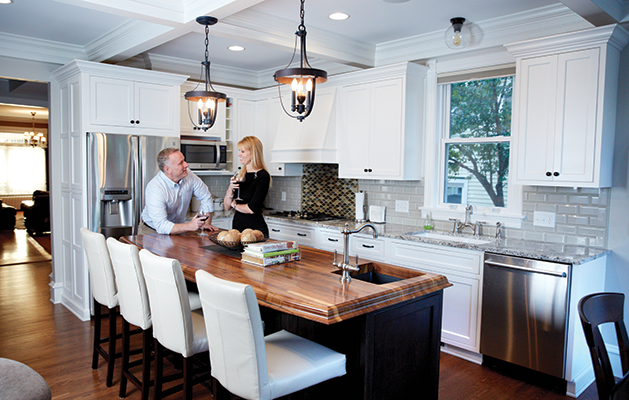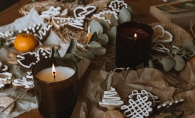
Renovating a historic home is no easy task; it’s probably best described as a balancing act. How do you maintain the vintage charm and character—hardwood floors, ornate crown molding and intricate details—while making the house fit for modern life? Fixer-uppers can prove time-consuming and expensive, and they might not be for everyone, but those who have successfully brought an old house back to life say that the final results make the hard work worthwhile.
Case Study No. 1: Romantic Reno
Kevin Knoke and his wife, Jill, bought their downtown Stillwater home in the mid-2000s, but the house has been a fixture in the neighborhood since the late 19th century. Known as the Johnson House for its builder and original owner, Alexander Johnson, the home was built in 1892. The original bill of sale—which Kevin and Jill actually have—shows a cost of $1,800.
Since purchasing the house, the Knokes have completed various renovations—updating the once-unfinished attic and remodeling various rooms, plus smaller updates throughout. A major renovation on the original kitchen was recently completed by Chris Koss of 1st Choice Builders in Stillwater. “The 1892 kitchen was really tiny,” Kevin Knoke says, noting that in the late 19th and early 20th centuries it was common for houses to have two kitchens—a “summer kitchen” detached from the house and an in-house kitchen for the chillier months. In the Johnson House, Knoke says, “There used to be a breezeway that led to the summer kitchen, but that had been enclosed into what’s called a boundary room.”
To renovate the back of the house, they had the boundary room, along with most of the back of the house, torn down to the ground, but preserved the back stairwell, which was likely once used as servants’ passage. “We left that, because if we were to tear it out, we would’ve never been able to replace it,” Knoke says. “At one point during the construction process, it was completely demolished except for that staircase that went up to nowhere.” They built around the staircase, also remodeling the back bathroom, where they preserved the old look and feel by having crown molding made to match the original.
Knoke says that the renovation led to the discovery of several artifacts from a bygone era. “We found spoons and a number of different things in the old summer kitchen,” he says, but notes that the most exciting find was an essay written by Alma Johnson, the daughter of the original builder. “She lived there from the time it was built to until 1996, when she went to a nursing home,” he says. “We found an essay she wrote about the Spanish-American War.”
Although it’s hard for Knoke to choose a favorite part of the house, the dining room is certainly a standout. “It has a huge pocket door—it must weigh a couple hundred pounds at least,” he says. “It’s solid oak, 6 feet long and 6 feet high, and that’s something you just don’t see that much of anymore.”
And, of course, being able to call a beautiful old house home is amazing. “It’s been a wonderful experience,” Knoke says. “Being downtown is just great.”
Case Study No. 2: Modern Commercial
Perhaps a less romantic restoration is one that Victoria Sass of design firm Project Refuge Studio spearheaded in the makeover of Stillwater’s Rivertown Eye Clinic. She and her team helped bring the optician’s office into the 21st century. The final results are stunning. What once was a dark and cramped space is now light and open, with a contemporary feel.
Sass says that the restaurants of Minneapolis’s North Loop served as the inspiration—“a little bit of that warehouse feeling, definitely something a little more contemporary.” Her team opened up the floor plan to integrate the reception and retail areas, and swapped the outdated teal and dark woods for a more natural color palette. They maintained some of the building’s original features, like the trim details around the ceiling. “We wanted to bring it into the modern day, but because it was a family-built business, we kept some of the architectural elements,” Sass says.
Sass and her team also collaborated with other small businesses and local designers like Minneapolis furniture makers Marvin Freitas of Form Co., and Keith Wyman of Concrete Pig. “Every store fixture was custom-designed for this space,” she says. “One of our passions at the design studio is working with small business and local makers, people who really love their raft.” Working with the staff of Rivertown Eye Clinic was a highlight as well. “They’re an amazing team of people. They were so fun to work with. They have really good heart, and they love their community and love what they do,” Sass says. “They were really trusting and just sort of let us take their space and totally reshape it without any kind of restrictions, and that was really fun.”
Case Study No. 3: DIY by Design
Todd and Jennifer Englund bought their Stillwater home, built in 1906, in 2010. Since then, they’ve completed three different renovations, wrapping up the most recent one—remodeling the attic—this past summer. “It was an unfinished third-story attic,” Todd Englund says. “There was one small part that was finished—from what we were told, that was the maid’s quarters—but other than that, it was just storage space.” Now the attic boasts two bedrooms, a bathroom, a living room and play area for the Englunds’ children.
They also came across a few pieces of the house’s history: Family photographs and nearly a dozen diaries from the house’s original owners. Englund says he hasn’t had the time to look through the diaries thoroughly, but looks forward to discovering all they have to say about his home’s story.
That sense of history is what he and his wife like the most about living where they do. “We love these old houses, and the reason why we love them so much is because of the history of the house,” Englund says. “That’s why we bought this house, because of the character and the quirkiness. With proper care, these old houses are going to be around forever.”









